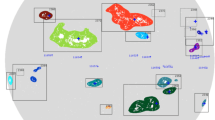Abstract
The X-Ray Spectroscopic Explorer (XRASE) has a unique combination of features that will make it possible to address many of NASA's scientific goals. These include how galaxy clusters form, the physics and chemistry of the ISM, the heating of stellar coronae, the amount and content of intergalactic baryonic matter, the mass of black holes and the formation of disks and jets in AGN and galactic binaries. XRASE has a thin foil, multilayered telescope with a large collecting area up to 10 keV, especially in the Fe Kα region (1100 cm2). Its microcalorimeter array combines high energy resolution (7 eV at 6 keV) and efficiency with a field-of-view of 26 arcmin2 . A deep orbit allows for long, continuous observations. Monitoring instruments in the optical (WOM-X), UV (TAUVEX) and hard X-RAY (GRAM) bands will offer exceptional opportunities to make simultaneous multi-wavelength observations.
Similar content being viewed by others
References
Christensen, F.E.,Westergaard, N.J. and Schnopper, H.W.: 1985, Measurements of surface scattering of X-rays using a triple axis X-Ray spectrometer, Proc. ESA Workshop on a Cosmic X-Ray Spectroscopy Mission, June 1985.
Fox, D.C. and Loeb, A.: 1997, Do the Electrons and Ions in X-Ray Clusters Share the Same Temperature?, Astrophys. J. 491, 459-466.
Romaine, S., Everett, J., Bruni, R., Ivan, A. and Gorenstein, P.: 1998, Characterization and Multilayer Coating of Cylindrical X-Ray Optics for X-Ray Astronomy, Proc. SPIE 3444, 552-555.
Schnopper, H.W.: 1967, Atomic Readjustment to an Inner-Shell Vacancy: Manganese K X-Ray Emission spectra from an Fe55 K-Capture Source and from the Bulk Metal, Phys. Rev. 154, 188-123.
Schnopper, H.W., Silver, E., Ingram, R., Christensen, F.E., Hussain, A., Barbera, M., Romaine, S., Collura, A., Kenter, A., Bandler, S. and Murray, S.: 1999, X-Ray optics made from thin plastic foils, Proc. SPIE 3766, in press.
Silver, E., LeGros, M., Austin, G., Madden, N., Beeman, J. and Haller, E.: 1997, First use of NTD germanium-based microcalorimeters for high-resolution, broadband X-Ray microanalysis, X-RAY SPECTROMETRY 26, 265-268.
Silver, E., Schnopper, H. and Ingram, R.: 1998, U. S. Patent Serial No. 09/064,476, filed April 22.
Author information
Authors and Affiliations
Rights and permissions
About this article
Cite this article
Schnopper, H.W., Silver, E., Murray, S. et al. XRASE: The X-Ray Spectroscopic Explorer. Astrophysics and Space Science 276, 49–65 (2001). https://doi.org/10.1023/A:1012023012177
Issue Date:
DOI: https://doi.org/10.1023/A:1012023012177




